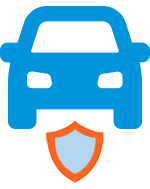The following pages have been prepared to give you some of the most important rules to remember before your theory test.
If you get very nervous at going to the theory test, then it might be a good idea to not tell too many about it so that you don't put extra pressure on yourself. Also you could order the theory test early in the morning so you don't have much time to think about it.
If you are nervous about passing the theory test at Færdselsstyrelsen, then pass all our 40 tests and topic tests (at least in the second attempt for Beståelsesgaranti) and you will be well prepared.
Mostly your first answer is correct, by 80%, so think twice before you change your answer. Only if you are 100% sure should you change your answer.
When you answer the questions and have doubts about a single image, then you should not focus only on that, because there is a risk that you do not hear the next question. But if in doubt, do not not answer - that will count as a mistake if there is no answer.
You must have at least 20 correct images of 25 images to pass the test. Multiple errors in an image count as one error, so 20 out of 25 images should be error-free. Do not skip the answers because you cannot recall the question later. The test at the police is not intended to make you fail, but to check that you have the necessary knowledge of the most important rules and to see how you will react in the different traffic situations. (always remember to be critical and never take chances).
Choose one of the topics:
Awareness
You always have to be aware of everything around you but you can pay particularly/ special attention to only 2-3 things at a time.
To be particularly aware of:
Something or someone in front of you or behind you, that may have an impact on the continuation of your driving, or something or someone that will certainly have an impact on the continuation of your driving over the next few seconds.Always pay particularly attention to what is closest to you, like children on a road. And do not pay particularly attention to what, for example, is further down the road and that does not affect your driving here and now.
Speed Restrictions
Speed restrictions must always be respected and you must never drive faster than what is the limit on the traffic sign.
You must drive 50 km/h in built-up areas when there are good driving conditions. Always lower your speed when you get close to a traffic intersection without traffic lights. Drive about 5-10 km/h if you have to comply with your right hand duty, and approx. 30 km/h if the traffic from the side road has unconditional duty from their residential roads.
Pay special attention to children, the elderly, the disabled, and school patrols.
Inside a built-up area: 50 km/h
Outside a built-up area: 80 km/h
On a motorway: 130 km/h
On an express road/ motor traffic road: 80 km/hMaximum speed for:
Bus: 80 km/h
Truck: 80 km/h
Car with Trailer: 80 km/h
Tractor: 30 km/h, some tractors 40 km/h
When towing another vehicle: 30 km/h
You must adjust the speed so that you are able to stop the vehicle on time in the following situations (Slow down):
• At a crossroads with poor visibility / where the situation is not clear • In a turn with poor vision • Before a pedestrian field with poor visibility • Before a hilltop with poor views • When there is a risk of dazzling oncoming drivers • When meeting on a narrow road • When the road is wet or slippery • As you approach a bus where people get off • As you approach children on or near the road • As you approach horses, cows or other animals on the road • When there is road work • Near places where there have been traffic accidents • Before railroad crossings • If your vision is impaired for any reasonStopping and parking
Means any free placement of the car for 3 minutes or longer No matter where the driver is. (inside or outside the car)
And as long as we are not speaking of anything with passengers or goods, because then it is considered a stopping.
The prohibition sign has one diagonal line = 1 prohibition.
Stopping and parking are prohibited in the following unmarked places:
• On the left side of the road, except for less travelled roads and one-way roads • On footpath, bicycle path, centre stripe, traffic island, hatched markings or the like and generally on pavement • On a pedestrian field or closer than 5 meters in front of the field • At the exit of the bicycle path or closer than 5 meters before the exit • At junctions or closer than 10 meters from the nearest edge of the crossing street or bicycle path, however always permitted in parking bay • Closer than 5 meters from the start of a barrier up to a junction • Next to the barrier if the distance between the car and the barrier is less than 3 meters(However, this does not apply if the line is dotted)
• On a railway or other overpass • On or below bridges over motorway or in tunnels • On or near the hilltop. • In turns with poor vision • If your parking covers traffic signs or signals • In a crawler lane • In marked area for taxi • On a disability parking • At the bus stop - 12 meters before a bus stop, although there are no road signs.
If the distance of 12 meters is extended by yellow curb marking, the prohibition applies to the entire marked stretch.
• On the motortrafficway • On the motorway
Parking is prohibited in the following unmarked places:
• Closer than 30 meters before or after a railway crossing • Exit of properties or so that access/exit is significantly more difficult • On main roads outside built-up areas • Next to another stopped or parked vehicle, it is allowed though if it is next to a 2-wheel vehicle (not if the motorbike has a trailer)
Terms commonly used for the theory test:
When setting off from the roadside or making a change of position to the left or right, always orient yourself to see if there are any in your blind spots. (there must be orientation in the question otherwise you must not start immediately, change course)

Safe handling of traffic
You have to actively participate in the traffic flow. Always try to follow the others quickly to the legal speed (remember to be critical if there is fog or similar bad conditions.) If it is possible to overtake trucks, tractors or busses, then do so. But not if the other vehicle is faster than your car.
(e.g. trucks without trailers)The size of the car
The maximum size of a car with or without goods is: 12 meters long, 4 meters high and 2.55 wide.
Danger, disadvantage and unnecessary disadvantage
Never endanger yourself or others. You are "at a disadvantage" if you drive in a way that, without being in danger, gets in the way of the other road users and forces them to slow down / increase speed, change location on the road or hold back.
For certain manoeuvres, e.g. starting from the curb, changing lanes (all parallel manoeuvres) and in the case of sudden stopping, you can not always avoid getting in the way of others (packed traffic), but you must ensure that the manoeuvre is not to "unnecessary inconvenience".
In all manoeuvres when you meet others, you must not be at a disadvantage, whether there is packed traffic or not.
Orientation
It is a typical answer yes.
You should always orientate yourself for "possible" pedestrians, cars, oncoming traffic...
Doing something immediately is a typical no answer unless everything is clear and it is allowed to perform the intended manoeuvre.
Alcohol
It is illegal to drive with a BAC over 0.50, which is equivalent to over 0.25 mg per liter of air you exhale. You must also remember that if you are involved in a traffic accident or driving unsafely, you can be convicted for alcohol driving even though your BAC is below the limit.
It is forbidden to leave your car to someone who is obviously intoxicated. Medication and drugs can be as dangerous as alcohol and a mixture of alcohol / medicine / drugs will make driving a car even more dangerous. The police can demand breath tests from you at any time.
Risk conditions on the roads
The roads surroundings:
i.e. buildings and density of buildings, vegetation, forest, open fields, the sea, lakes, bridges, etc. along the road. (What surrounds the road and makes the lane more slippery or affects your driving in some way)
Road equipment or standard:
e.g. narrow or wide lane, the paving of the roadway, condition, lane stripes, road bumps, pavement, bicycle path, pedestrian crossing and road lighting. (Typical questions about the road equipment will be a picture with a missing pavement or bicycle path and you must also pay special attention to the missing road equipment.
Course of the road:
i.e. intersections, junctions, roundabouts, turns, hills, railroad crossings, tunnels and road narrowing.
The road's use:
i.e. the density and nature of the traffic may be determined by local targets (school, bus- or trainstation, shopping mall, sports ground, stadium, cinema, nursing home, etc.).
Type or class of road:
i.e. motorway, motortrafficroad, mainroad, speed restricted/ attenuated area, pedestrian zone, residential area and tunnel. (You will typically see the board stating that such a road starts).
Police officer's signature:
When you can see the officer's chest or back regardless of the position of the arms, it is the same as red light.
Driving in the direction along the police officer's arm is the same as green light. The arm up means stop for everyone at an intersection.
Overtaking
You always have to overtake left - the only exception is when the car in front of you turns left and the lane to your right is not a special lane (clearly marked bicycle path, turn lane or bus lane).
It is forbidden to overtake:
• Before or on a railway crossing, • Before or in a pedestrian field (if the oncoming car covers the view), • Before a hilltop, • Heading into a bend (where there is poor vision), • Before or at a junction (unless there are several lanes in the same direction)You can overtake:
• If there is a 100% good view of the entire stretch, • If there are two or more lanes in your direction and a blocking line so that oncoming lanes cannot get in your lane half, • If there are two lanes in a traffic light and you overtake right on a car that turns left.You must have full vision (and it must be free of oncoming and obstacles on the road) over the overtaking stretch before you decide to start overtaking.
Duties
Unconditional duty means that you must show that you can and will stop and hold back for traffic coming from both your right and left.
You have unconditional duty in the following situations:
• There are shark teeth, • There is a road sign for unconditional duty (triangular board with the point down), • There is a stop sign (meaning full stop) • Driving into a roundabout, • When crossing a sidewalk - a bicycle path - you enter or exit from a garage or private property, • Leaving a parking lot, gas station, gravel road or leaving a clearly subordinate road that has a different surface (typically cobblestone). • Leaving a pedestrian area, living- and playarea.Right hand duty means that you have to wait for all vehicles coming from your right. This applies where the rules for unconditional duty is not present.
(These rules do not apply for merging or changing lanes!).
Reduced Grip
There is reduced grip when you can see;
ice or snow on the road, holes in the road, water pits, oil spilled etc.
or the road is gravel etc.Remember that shadows or leaves from trees increase the risk of a slippery road. In the summer the grip is almost never reduced.
Location on the road
You should place your car as far to the right as possible without getting to close to any cyclists, mopeds, parked vehicles and pedestrians. You should position yourself in the right lane and only use the left for overtaking or passing. Place yourself in the middle when the lane is marked. Turn right on narrow roads before a hilltop and before turns with a poor vision.
Left Turns
Always wait for the oncoming traffic, never take a turn if you are to take chances.
Pay particular attention to oncoming traffic, light signal and any pedestrians on the side road you want to turn onto.
General rule is: larger left turn and small right turn.
Right Turns
At the right turn, keep to the right and close the space for cyclists and mopeds coming from behind (when free) and do not turn straightaway, even if there is a green light, if you have not checked to the right side.
If you stop for pedestrians before turning, make sure you do not block the bicycle path.

Children
When you see children running, playing, or cycling, you typically need to respond by slowing down and by adding extra distance to them. You must always be prepared for children to respond impulsively.
Yellow Lines
When there are yellow lines then you should pay special attention to them rather than the normal white lines. But white stop lines at an intersection or at pedestrian lanes are still valid.
On the highway, never
Back, turn, stop, park, use emergency telephone, (unless you have a motor stop or in case of an emergency), the emergency track is only for ambulances, fire trucks, cars in serious trouble or the like.
When entering a motorway, adjust your speed to the others already on the freeway and follow the lane to where it meets the right lane of the motorway. (when merging, do not drive over any lines) Before driving onto the highway, always remember to look in the mirror and the blind angle.


 English
English Dansk
Dansk Srpski
Srpski Español
Español Kurdî
Kurdî اُردُو
اُردُو Français
Français Hrvatski
Hrvatski 简体中文
简体中文 العربية
العربية Türkçe
Türkçe Românește
Românește ትግርኛ
ትግርኛ Af Soomaali
Af Soomaali فارسی
فارسی Shqipja
Shqipja Filipino
Filipino ไทย
ไทย Русский
Русский tiếng Việt
tiếng Việt नेपाली
नेपाली Lietuvių
Lietuvių Polski
Polski Bosanski
Bosanski Crnogorski
Crnogorski Українською
Українською Magyar nyelv
Magyar nyelv